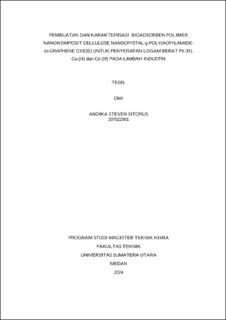Pembuatan dan Karakterisasi Bioadsorben Polimer Nanokomposit Cellulose Nanocrystal-g-Poly(Acrylamide-co-Graphene Oxide) untuk Penyerapan Logam Berat Pb (II), Cu (II) dan Cd (II) pada Limbah Industri
Fabrication and Characterisation of Cellulose Nanocrystal-g-Poly (Acrylamide-co-Graphene Oxide) Polymer Bioadsorbent for Removal of Heavy Metals Pb (II), Cu (II) and Cd (II) from Industrial Wastewater

Date
2024Author
Sitorus, Andika Steven
Advisor(s)
Sarah, Maya
Harahap, Hamidah
Metadata
Show full item recordAbstract
The removal of heavy metals in industrial wastewater by adsorption method using
nanocomposite bioadsorbent of nanocrystalline cellulose (CNC) functionalised
with graphene oxide was able to reduce the content of Pb, Cu and Cd metals. This
study used bioadsorbent from sugarcane bagasse isolated into cellulose and
hydrolysed with 40% sulfuric acid to produce nanocrystalline cellulose and
characterised to examine the particle size using PSA (Particle Size Analyzer). In
the grafting process, graphene oxide was varied by weight of 0, 20, 40, 60 and 80
mg and freeze drying was carried out to formed hydrogels and obtained 5 hydrogel
models as adsorbents for the removal of Pb, Cu and Cd metals. This study aims to
determine the efficiency of the swelling kinetics process for Pb, Cu and Cd metals,
to analyse the adsorption isotherms and kinetics of the hydrogel adsorbent in batch.
The resulting hydrogels were characterised using Fourier-Transform Infrared (FTIR),
X-ray diffraction (XRD), Scanning Electron Microscopy (SEM) and Thermal
Stability (TG/DTG). The swelling kinetics process was carried out with variation
of time and pH. The obtained hydrogels were able to increase the adsorption
capacity at pH 6-7. Adsorption of Pb, Cu and Cd metals demonstrated that the
kinetis data followed a pseudo second-order equation, while the adsorption
isotherm model followed the Langmuir model. The maximum adsorption capacity
is obtained in hydrogel CNC-g-P(AM/GO-0) for Pb (149.99 mg/g), Cu (193.03
mg/g) and Cd (176.73 mg/g), hydrogel CNC-g-P(AM/GO-20) for Pb (132.45 mg/g),
Cu (133.5119 mg/g) and Cd (156.8 mg/g), hydrogel CNC-g-P(AM/GO-40)metals
Pb (121.74 mg/g), Cu (111.46 mg/g) and Cd (135.89 mg/g), hydrogel CNC-g-
P(AM/GO-60) for Pb (129.75 mg/g), Cu (94.07 mg/g) and Cd (114.85 mg/g),
hydrogel CNC-g-P(AM/GO-80) for Pb (163.09 mg/g), Cu (87.03 mg/g) and Cd
(108.7 mg/g). The results of this study showed that the synthesised hydrogels were
still effective in the removal of Pb, Cu and Cd in wastewater.
Collections
- Master Theses [142]
